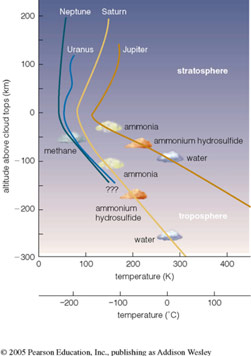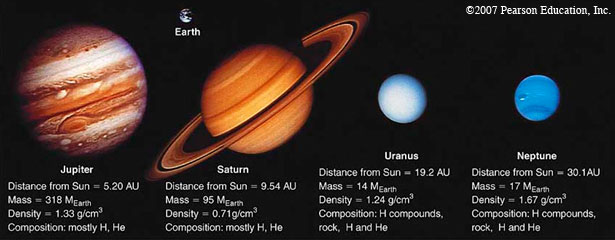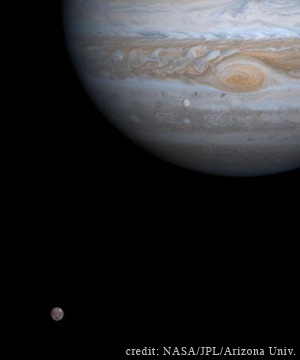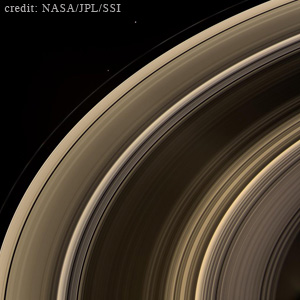
What Are They, and Where Are They?What Are They, and Where Are They?
SUMMARY: The jovian planets are essentially big balls of gas, each surrounded by many moons and rings.
Composition
Rotation
Moons and Rings
Why so different?
Atmospheres
Interiors
Related links
Related Lessons:
Jupiter's Relative Size
The Great Red Spot Pinwheel
Can Photosynthesis Occur at Saturn?
Patterns and Fingerprints
Using Spectral Data To Explore Saturn and Titan
Composition
Jupiter, Saturn, Uranus and Neptune collectively make up the group known as the jovian planets. The general structures of the jovian planets are opposite those of the terrestrial planets. Rather than having thin atmospheres around relatively large rocky bodies, the jovian planets have relatively small, dense cores surrounded by massive layers of gas. Made almost entirely of hydrogen and helium, these planets do not have solid surfaces.
Rotation
Unlike the spherical shapes of terrestrial planets, the jovian planets are all slightly oblong. The jovian planets rotate much faster than any of the terrestrial worlds. Gravity by itself would make a planet spherical, but their rapid rotation flattens out their spherical shapes by flinging material near the equator outward.
Observations of clouds at different latitudes suggest that the jovian planets rotate at different speeds near their equators than near their poles.
JOVIAN "DAYS"
- Jupiter : 10 hours
- Saturn : 10 hours
- Uranus : 16-17 hours
- Neptune : 16-17 hours
Moons and Rings
After size, perhaps the most noticeable difference between the jovian and terrestrial planets involves moons and rings. The terrestrial planets are nearly isolated worlds, with only Earth (1 moon) and Mars (2 moons) orbited by any moons at all. In contrast, many moons and rings orbit each of the jovian planets.
All four jovian planets have rings, although only Saturn's rings are easily visible from Earth. Rings are composed of countless small pieces of rock and ice, each orbiting its planet like a tiny moon. The rings look flat because the particles all orbit in essentially the same plane. The rings are located closer to the planets than any of their moderately sized or large moons, but the inner edge of the rings is still well above the planet's cloud tops.
Why so Different
Why are the jovian planets so different from the terrestrial planets? We can trace almost all the differences to the formation of the solar system. The frost line marked an important dividing point in the solar nebula. Within the frost line, temperatures were too high for hydrogen ices to form. The only solid particles were made of metal and rock. Beyond the frost line, where hydrogen compounds could condense, the solid particles included ices as well as metal and rock.
While terrestrial planets accreted from planetesimals made of rocks and metals, they ended up too small to capture significant amounts of the abundant hydrogen and helium gas in the solar nebula. The jovian planets, however, formed farther from the Sun where ices and rocks were plentiful. The cores accreted rapidly into large clumps of ice and rock. Eventually, they got so large, they captured a large amount of hydrogen and other gasses from the surrounding nebula with their enormous gravity.
MORE INFO ON PLANET FORMATION SOME QUICK PLANET FACTS
Atmospheres

Cloud Altitudes in Jovian Planet Atmospheres
The atmospheres of Jupiter and Saturn are made almost entirely of hydrogen and helium, although there is some evidence they contain hydrogen compounds. Uranus and Neptune are made primarily of hydrogen compounds, with smaller traces of hydrogen, helium, metal and rock. The most common hydrogen compounds are methane (CH4), ammonia (NH3), and water (H2O).
The farther away a planet is from the Sun, the cooler its atmosphere will be. This means that the same gases will condense to form clouds at different altitudes on different planets because the condensation of a gas requires a specific amount of pressure and temperature. Ammonia, ammonium hydrosulfide and water make up the 3 cloud layers of Jupiter and Saturn. You can see from the graph to the right that these condense at lower altitudes in Saturn's atmosphere than they do in Jupiter's atmosphere.
Interiors
The cores of all four jovian planets are made of some combination of rock, metal and hydrogen compounds. Jupiter and Saturn have similar interiors, with layers extending outward of metallic hydrogen, liquid hydrogen, gaseous hydrogen, and topped with a layer of visible clouds. Unlike Jupiter and Saturn, Uranus and Neptune have cores of rock and metal, but also water, methane and ammonia. The layer surrounding the core is made of gaseous hydrogen, covered with a layer of visible clouds similar to Jupiter's and Saturn's.
Just like the terrestrial planets, the deeper you go, the hotter and denser it gets. An increase in temperature and density means an increase in pressure.

A Pie Slice of Jupiter's Density
The
Eric Weisstein's world of astronomy






